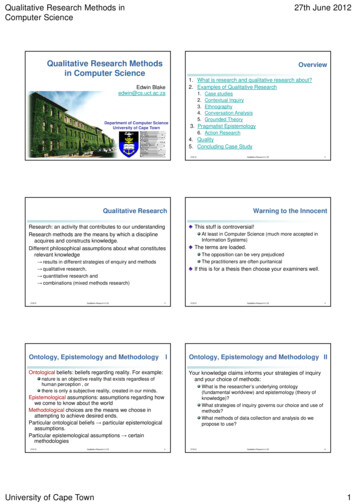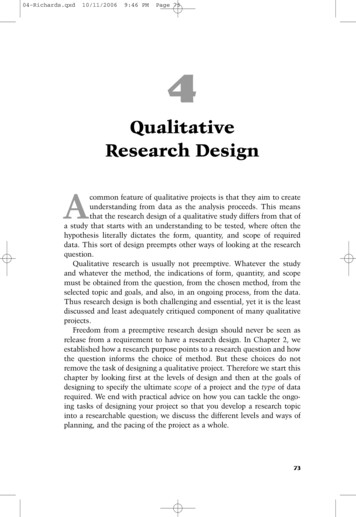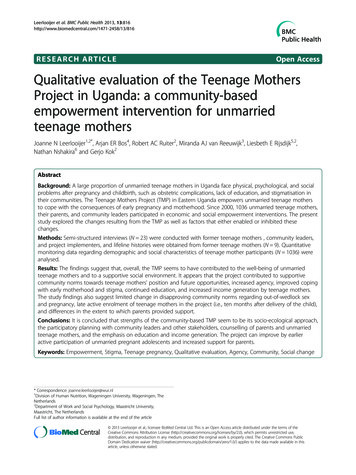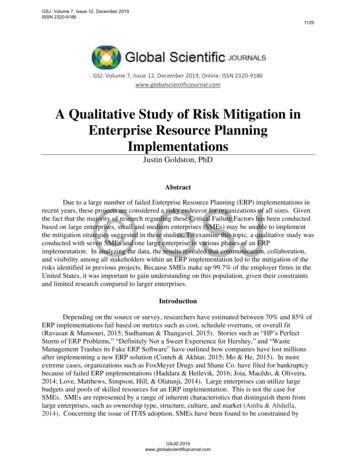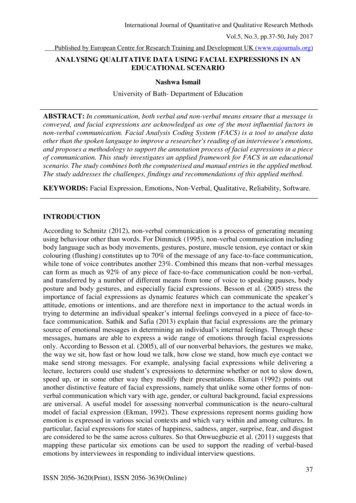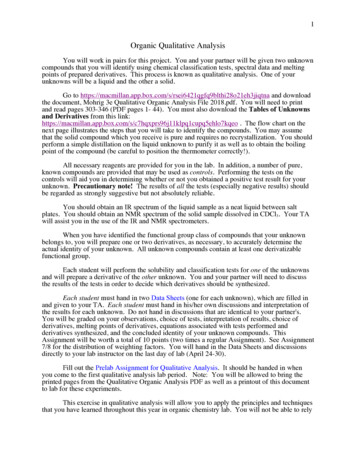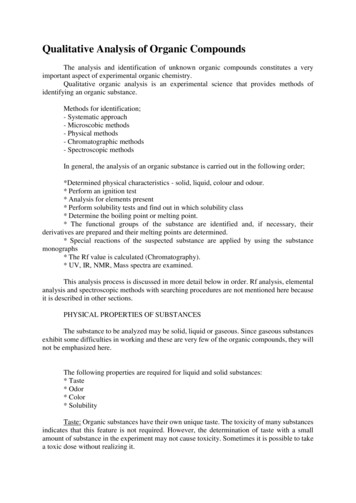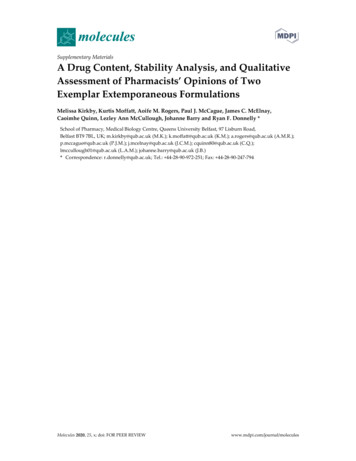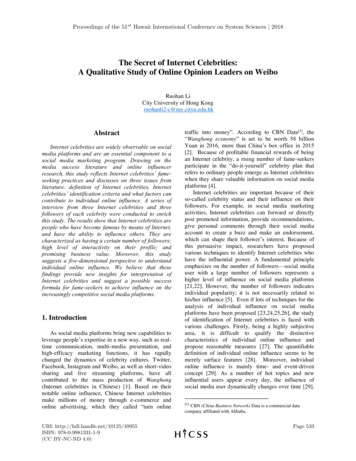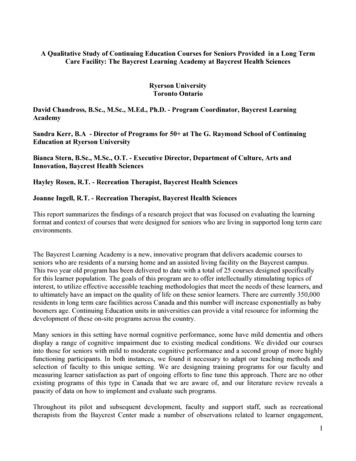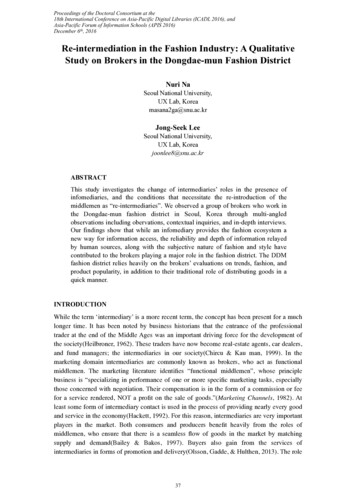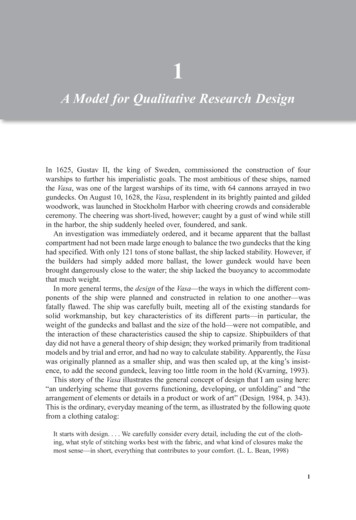
Transcription
1A Model for Qualitative Research DesignIn 1625, Gustav II, the king of Sweden, commissioned the construction of fourwarships to further his imperialistic goals. The most ambitious of these ships, namedthe Vasa, was one of the largest warships of its time, with 64 cannons arrayed in twogundecks. On August 10, 1628, the Vasa, resplendent in its brightly painted and gildedwoodwork, was launched in Stockholm Harbor with cheering crowds and considerableceremony. The cheering was short-lived, however; caught by a gust of wind while stillin the harbor, the ship suddenly heeled over, foundered, and sank.An investigation was immediately ordered, and it became apparent that the ballastcompartment had not been made large enough to balance the two gundecks that the kinghad specified. With only 121 tons of stone ballast, the ship lacked stability. However, ifthe builders had simply added more ballast, the lower gundeck would have beenbrought dangerously close to the water; the ship lacked the buoyancy to accommodatethat much weight.In more general terms, the design of the Vasa—the ways in which the different components of the ship were planned and constructed in relation to one another—wasfatally flawed. The ship was carefully built, meeting all of the existing standards forsolid workmanship, but key characteristics of its different parts—in particular, theweight of the gundecks and ballast and the size of the hold—were not compatible, andthe interaction of these characteristics caused the ship to capsize. Shipbuilders of thatday did not have a general theory of ship design; they worked primarily from traditionalmodels and by trial and error, and had no way to calculate stability. Apparently, the Vasawas originally planned as a smaller ship, and was then scaled up, at the king’s insistence, to add the second gundeck, leaving too little room in the hold (Kvarning, 1993).This story of the Vasa illustrates the general concept of design that I am using here:“an underlying scheme that governs functioning, developing, or unfolding” and “thearrangement of elements or details in a product or work of art” (Design, 1984, p. 343).This is the ordinary, everyday meaning of the term, as illustrated by the following quotefrom a clothing catalog:It starts with design. . . . We carefully consider every detail, including the cut of the clothing, what style of stitching works best with the fabric, and what kind of closures make themost sense—in short, everything that contributes to your comfort. (L. L. Bean, 1998)1
2Q u a l itat iv e R e s e a r c h D e s ig nA good design, one in which the components work harmoniously together, promotesefficient and successful functioning; a flawed design leads to poor operation or failure.However, most works dealing with research design use a different conception ofdesign: “a plan or protocol for carrying out or accomplishing something (esp. a scientific experiment)” (Design, 1984, p. 343). They present “design” either as a menu ofstandard types of designs from which you need to choose (typical of experimentalresearch), or as a prescribed series of stages or tasks in planning or conducting a study.Although some versions of the latter view of design are circular and recursive (e.g.,Marshall & Rossman, 1999, pp. 26–27), all are essentially linear in the sense of being aone-directional sequence of steps from problem formulation to conclusions or theory,though this sequence may be repeated. Such models usually have a prescribed startingpoint and goal and a specified order for performing the intermediate tasks.Neither typological nor sequential models of design are a good fit for qualitativeresearch, because they attempt to establish in advance the essential steps or features ofthe study. (See Maxwell & Loomis, 2002, for a more detailed critique of theseapproaches.) In qualitative research, any component of the design may need to bereconsidered or modified during the study in response to new developments or tochanges in some other component. In this, qualitative research is more like sciencessuch as paleontology than it is like experimental psychology. The paleontologist NeilShubin (2008) described his fieldwork as follows:The paradoxical relationship between planning and chance is best described by GeneralDwight D. Eisenhower’s famous remark about warfare: “In preparing for battle, I havefound that planning is essential, but plans are worthless.” This captures field paleontologyin a nutshell. We make all kinds of plans to get to promising field sites. Once we’re there,the entire field plan may be thrown out the window. Facts on the ground change our bestlaid plans. (p. 4)This description also characterizes qualitative research, in which designs are flexiblerather than fixed (Robson, 2011), and inductive rather than following a strict sequenceor derived from an initial decision. In a qualitative study, “research design should be areflexive process operating through every stage of a project” (Hammersley & Atkinson,1995, p. 24). The activities of collecting and analyzing data, developing and modifyingtheory, elaborating or refocusing the research questions, and identifying and addressingvalidity threats are usually all going on more or less simultaneously, each influencingall of the others. This process isn’t adequately represented by a choice from a priormenu or by a linear model, even one that allows multiple cycles, because in qualitativeresearch, there isn’t an unvarying order in which the different tasks or components mustbe arranged, nor a linear relationship among the components of a design.Typological or linear approaches to design provide a model for conducting theresearch—a prescriptive guide that arranges the tasks involved in planning or conducting a study in what is seen as an optimal order. In contrast, the model in this book is amodel of as well as for research. It is intended to help you understand the actual designof your study, as well as to plan this study and carry it out. An essential feature of this
Chapter 1 A Model for Qualitative Research Design3model is that it treats research design as a real entity, not simply an abstraction or plan(Maxwell, 2011b). The design of your research, like the design of the Vasa, is real andwill have real consequences. Borrowing Kaplan’s (1964, p. 8) distinction between the“logic-in-use” and “reconstructed logic” of research, this model can be used to represent the “design-in-use” of a study, the actual relationships among the components ofthe research, as well as the intended (or reconstructed) design. As Yin (1994) stated,“Every type of empirical research has an implicit, if not explicit, research design”(p. 19). Because a design always exists, it is important to make it explicit, to get it out in theopen where its strengths, limitations, and consequences can be clearly understood.This conception of design as a model of, as well as for, research is exemplified in aclassic qualitative study of medical students (Becker, Geer, Hughes, & Strauss, 1961).The authors began their chapter on the design of the study by stating,In one sense, our study had no design. That is, we had no well-worked-out set of hypothesesto be tested, no data-gathering instruments purposely designed to secure information relevant to these hypotheses, no set of analytic procedures specified in advance. Insofar as theterm “design” implies these features of elaborate prior planning, our study had none.If we take the idea of design in a larger and looser sense, using it to identify those elements of order, system, and consistency our procedures did exhibit, our study had a design.We can say what this was by describing our original view of the problem, our theoreticaland methodological commitments, and the way these affected our research and wereaffected by it as we proceeded. (p. 17)Thus, to design a qualitative study, you can’t just develop (or borrow) a logical strategy in advance and then implement it faithfully. You need, to a substantial extent, toconstruct and reconstruct your research design, and this is a major rationale for mydesign model. Qualitative research design, to a much greater extent than quantitativeresearch, is a “do-it-yourself” rather than an “off-the-shelf” process, one that involves“tacking” back and forth between the different components of the design, assessingtheir implications for one another.1 It does not begin from a predetermined starting pointor proceed through a fixed sequence of steps, but involves interconnection and interaction among the different design components.In addition, as the architect Frank Lloyd Wright emphasized, the design of something must fit not only its use, but also its environment (“Organic Architecture,” n.d.).You will need to continually assess how your design is actually working during theresearch and how it influences and is influenced by the context in which you’re operating, and to make adjustments and changes so that your study can accomplish whatyou want.My model of research design, which I call an “interactive” model (I could just as wellhave called it “systemic”), has a definite structure. However, it is an interconnected andflexible structure. In this book, I describe the key components of a research design, andpresent a strategy for creating coherent and workable relationships among these components. I also provide (in Chapter 7) an explicit plan for using your design to create aresearch proposal.
4Q u a l itat iv e R e s e a r c h D e s ig nThe model I present here has five components, each of which addresses a specific setof concerns:1. Goals. Why is your study worth doing? What issues do you want it to clarify, and whatpractices and policies do you want it to influence? Why do you want to conduct this study,and why should we care about the results?2. Conceptual framework. What do you think is going on with the issues, settings, or peopleyou plan to study? What theories, beliefs, and prior research findings will guide or informyour research, and what literature, preliminary studies, and personal experiences will youdraw on for understanding the people or issues you are studying?3. Research questions. What, specifically, do you want to better understand about the settingsor participants that you are studying? What do you not know about these that you want tolearn? What questions best capture these learnings and understandings, and how are thesequestions related to one another?4. Methods. What will you actually do in conducting this study? What approaches and techniques will you use to collect and analyze your data? I identify four parts of this componentof your design: (a) the relationships that you establish with the participants in your study;(b) your selection of settings, participants, times and places of data collection, and otherdata sources such as documents (what is often called “sampling,” although this term can bemisleading for qualitative research, as I discuss in Chapter 5); (c) your methods for collecting your data; and (d) your data analysis strategies and techniques.5. Validity. How might your results and conclusions be wrong? What are the plausible alternative interpretations and validity threats to these results and conclusions, and how will you dealwith these? How can the data that you have, or that you could potentially collect, support orchallenge your ideas about what’s going on? Why should we believe your results?These components are not substantially different from the ones presented in manyother discussions of research design (e.g., LeCompte & Preissle, 1993; Miles &Huberman, 1994; Robson, 2011; Rudestam & Newton, 2007, p. 5). What is innovative is the way the relationships among the components are conceptualized. In thismodel, the different parts of a design form an integrated and interacting whole, witheach component closely tied to several others, rather than being linked in a linear orcyclic sequence. The relationships among these five components are displayed inFigure 1.1.In this model, in contrast to some other views of research design, the research questions are not the starting point or controlling piece of the design, to which all othercomponents must conform. Instead, they are at the center of the design; they are theheart, or hub, of the model, the component that connects most directly to all of the othercomponents. They not only have the most direct influence on the other components, butare also the component most directly affected by the others; they should inform, and besensitive to, all of the other components. As discussed in more detail in Chapter 4, yourresearch questions are not fixed at the start of the study; they may need to be significantly modified or expanded as a result of changes in your goals or conceptual framework, or because of what you learn while doing the research.The upper triangle of this model, the half that is more conceptual and usually is thefirst that you develop, should be a closely integrated unit. Your research questionsshould have a clear relationship to the goals of your study, and should be grounded in
Chapter 1 A Model for Qualitative Research Design5Figure 1.1 An Interactive Model of Research HODSVALIDITYwhat is already known about the things you are studying and the theoretical conceptsand models that can be applied to these. In addition, the goals of your study should beinformed by current theory and knowledge, while your decisions about what theory andknowledge are relevant to your study depend on your goals and questions.Similarly, the bottom triangle of the model, the more operational half of the design,should also be closely integrated. The methods you use must enable you to answer yourresearch questions, and also to deal with plausible validity threats to these answers.Your questions, in turn, need to take into account the feasibility of the methods and theseriousness of particular validity t
Qualitative research design, to a much greater extent than quantitative research, is a “do-it-yourself” rather than an “off-the-shelf” process, one that involves “tacking” back and forth between the different components of the design, assessing their implications for one another. 1 It does not begin from a predetermined starting point or proceed through a fixed sequence of steps .
